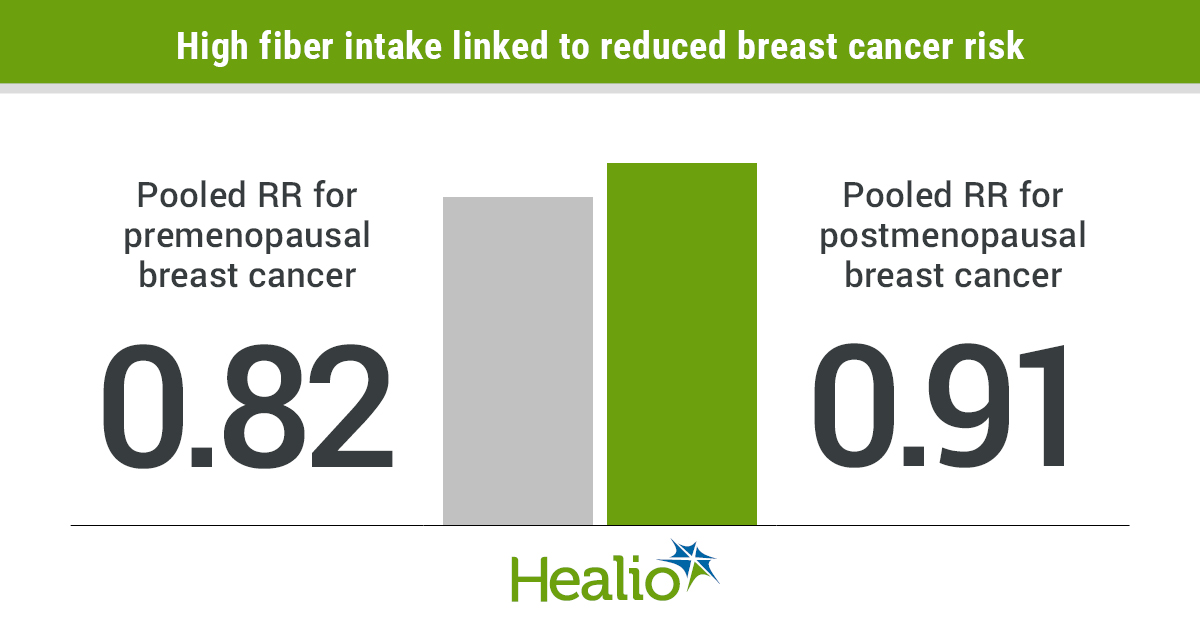Fiber consumption linked to lower breast cancer risk
High fiber consumption appeared to be associated with reduced risk for breast cancer, according to results of a meta-analysis of prospective observational studies published in Cancer.
These results appeared consistent for soluble fiber consumption, as well as for development of both premenopausal and postmenopausal breast cancer, researchers noted.
“Our study contributes to the evidence that lifestyle factors, such as modifiable dietary practices, may affect breast cancer risk,” Maryam S. Farvid, PhD, research scientist in the department of epidemiology at Harvard University School of Public Health, said in a press release. “Our findings provide research evidence supporting the American Cancer Society dietary guidelines, emphasizing the importance of a diet rich in fiber, including fruits, vegetables and whole grains.”
Results of prospective studies investigating possible associations between fiber intake and risk for breast cancer have been inconsistent. However, growing evidence suggests high circulating levels of insulin and insulin-like growth factor 1 are important as independent risk factors.

Additionally, previous analyses showed significant effects of sex hormone levels on breast cancer. Therefore, dietary factors that can lower levels of circulating insulin or insulin-like growth factor 1 or modify sex hormone levels may affect risk.
Farvid and colleagues conducted a systematic review and meta-analysis of 20 prospective studies that reported on the association between fiber consumption and incident breast cancer. These included 17 cohort trials, two nested case-control trials and one clinical trial. Participant totals across the trials varied from 270 to 691,571, with follow-up ranging from 2 to 20 years.
The meta-analysis included data on total fiber intake among 1,994,910 women (67,735 cases of breast cancer); cereal, fruit and vegetable fiber intake among 1,539,392 women (57,796 cases of breast cancer); legume fiber intake among 627,938 women (20,361 cases of breast cancer); soluble fiber intake among 586,302 women (19,588 cases of breast cancer); and insoluble fiber intake among 611,887 women (20,043 cases of breast cancer).
Results showed an association between total fiber consumption and an 8% lower risk for breast cancer when comparing the highest vs. lowest category (pooled RR = 0.92; 95% CI, 0.88-0.95; I2 = 12.6%).
Researchers observed a significant inverse association between soluble fiber consumption and breast cancer risk (pooled RR = 0.9; 95% CI, 0.84-0.96; I2 = 12.6%), whereas insoluble fiber appeared suggestively inversely associated with risk for breast cancer (pooled RR = 0.93; 95% CI, 0.86-1; I2 = 33.4%).
Higher total fiber intake appeared associated with lower risk for both premenopausal (pooled RR = 0.82; 95% CI, 0.67-0.99; I2 = 35.2%) and postmenopausal (pooled RR = 0.91; 95% CI, 0.88-0.95; I2 = 0%) breast cancer.
Researchers also reported a nonsignificant inverse association between total fiber intake and risk for both ER- and PR-positive and -negative breast cancers.
"The findings of the current study suggested that a high intake of total and soluble fiber was significantly associated with a reduced overall breast cancer incidence," Farvid and colleagues wrote. "In addition, insoluble fiber was found to be suggestively inversely associated with breast cancer risk. The reduction in risk appears to be similar for intake of all sources of fiber (cereal, fruit, vegetable and legume), although statistical significance was not reached, except for fruit fiber." – by John DeRosier
Disclosures: Farvid reports no relevant financial disclosures. Please see the study for all other authors’ relevant financial disclosures.

